Pur Natur bio activ
In addition to our traditional yoghurt starters, Pur Natur bio activ also contains three other bacterial strains: Pediococcus pentosaceus CECT 8330, Lactobacillus rhamnosus GG ATCC 53103 and Bifidobacterium longum CECT 7894. PUR NATUR has developed this product line for you together with AB-BIOTICS, experts in healthcare.
Why use bacterial strains and where do they come from?
Over time, the diversity of microorganisms in the digestive tract of the Western population has become more limited due to multiple influences, including eating habits, the use of medicines and antibiotics, air pollution, preserving agents, additives, etc.
The selected bacterial strains come from regions where people are not as exposed to these influences. We obtained these bacterial strains from people who are in good health and live in the countryside. Their microbial flora are much more diverse! These people are less influenced by the external factors that are so typical of the Western world, including antibiotics, processed food and the environment.
The unique pur natur formula with added yoghurt cultures
In addition to our traditional Pur Natur yoghurt cultures, Pur Natur bio activ contains three other bacterial strains: Pediococcus pentosaceus CECT 8330, Lactobacillus rhamnosus GG ATCC 53103 en Bifidobacterium longum CECT 7894.
Yoghurt contributes to a healthy, balanced and sustainable diet.
Live cultures in yoghurt aid in the digestion of lactose thanks to it’s fermentation activity also for those people who are lactose intolerant1.
Source: 1 Martini MC, Kukielka D, Savaiano DA. Lactose digestion from yogurt: influence of a meal and additional lactose. Am J Clin Nutr. May 1991;53(5):1253-1258.

We developed this product line for you together with AB-BIOTICS, a leading company of probiotics for healthcare.
THE AB-BIOTICS APPROACH
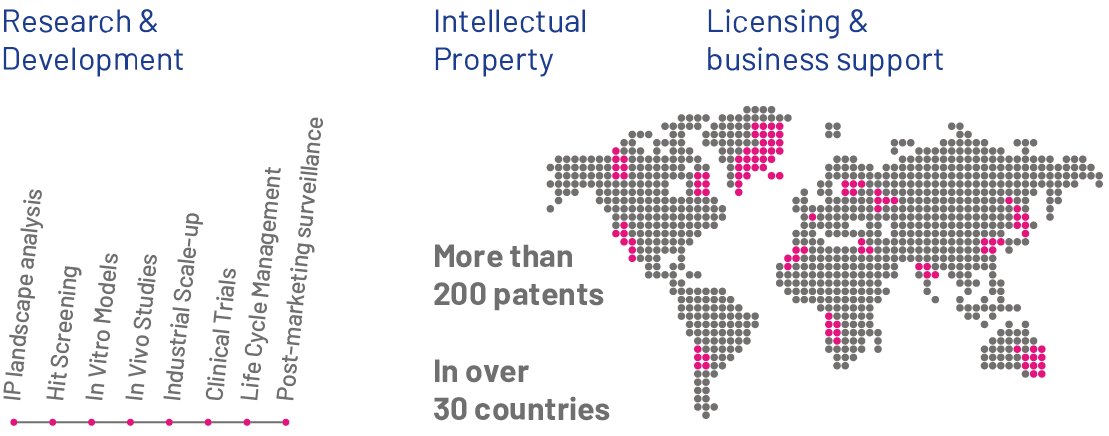
AB-BIOTICS focuses on the development of innovative probiotics based on the modulation of the microbiota. AB-BIOTICS is based in Barcelona and was founded in 2004. The company has its own vast collection of natural strains from around the world.
Why this formula?
The formula for Pur Natur bio activ yoghurt contains 3 additional, carefully-selected types of bacteria, i.e., Bifidobacterium, Pediococcus and Lactobacillus of human origin. The formula combines three strains, with proven and complementary efficacy for:
DIGEST PLUS STRAINS
The diversity and power of the commensal intestinal microbiota is enhanced by the AB-Digest probiotic formula because the strains are capable of:
- Surviving in a low pH environment and multiplying despite the presence of bile salts2
- Adhering to and colonising the intestinal tract2
- Improving the intestinal barrier and its permeability2
- Reducing the inflammatory response3
- Protecting against viral infections2
- Neutralising enteropathogenic bacteria3
- Promoting a homofermentative metabolism3
Source:
2 Segers ME, Lebeer S. Towards a better understanding of Lactobacillus rhamnosus GG - host interactions. Microbial Cell Factories. 2014;13(Suppl 1):S7-S23.
3 Santas J et al. Pediococcus pentosaceus CECT 8330 and Bifidobacterium longum CECT 7894 vertonen de neiging om overmatig huilen bij baby’s te beperken in een klinische pilootstudie. Int J Pharma Bio Sci 2015; 6(2):P458–66.
1. The intestinal microbiota
We are 90% bacterial and 10% human.
The human digestive tract is a complex ecosystem, that is home to millions of microorganisms and hundreds of different types of bacteria. The human microbiome consists of ten times more microbial than human cells, i.e., 100 billion. Our gut flora contains more than three million microbial genes, or 150 times more genes than in the human genome. More than 1,000 different known bacterial species can be found in human gut microbiota but only 150 to 170 predominate in any given subject.
Most gut microbes are harmless or even beneficial to the host. They protect against stomach and intestinal pathogens (the bacteria that cause food-borne infections), help extract nutrients and energy from food and contribute to normal immune function. Some of these bacteria may be potentially dangerous. But they are usually kept in check by good bacteria to maintain the so-called microbiota balance.
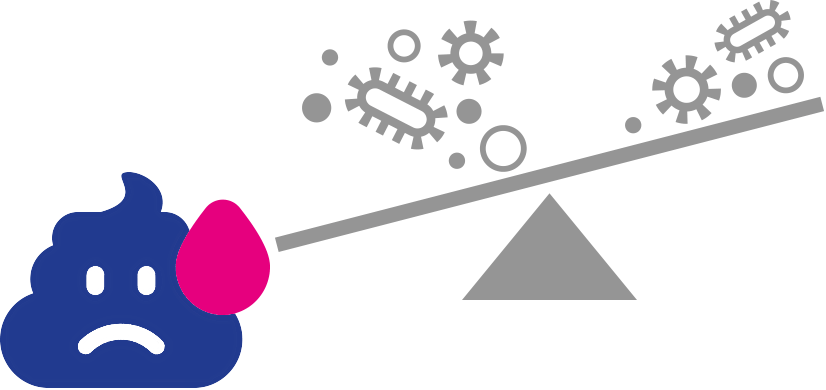
Disruptions of this delicate balance are linked to obesity, malnutrition, unhealthy eating, illness, stress, etc.. A microbial imbalance can also trigger infections with opportunistic pathogens, causing various episodes of diarrhoea for example. Various factors can disrupt the microbial balance in the intestine, such as the use of medicines in case of illness, e.g., antibiotics. Treatments with antibiotics partly destroy microbial populations, the commensal microbiota is decreased, creating an environment that is susceptible to pathogenic and opportunistic intruders.
Dysbiosis of intestinal microbiota can also be caused by pathogenic (bacterial) infections such as listeria and salmonella.
Diarrhoea can be caused by viral infections such as the rotavirus and infections.
Digest plus strains
Lactobacillus rhamnosus GG ATCC 53103 inhibits the growth of pathogenic bacteria such as Listeria spp or Salmonella spp. in vitro. These effects were observed in vivo, in at least two recent independent clinical studies (one in Caucasian infants and another with an Asian population of allergic adults), which showed that the consumption of Lactobacillus rhamnosus GG ATCC 53103 increases the wealth of Lactobacillus, butyrogenic bacteria such as Ruminococcus and the diversity of the microbiota in general. These studies also showed that Lactobacillus rhamnosus GG ATCC 53103 reduces the numbers of potential enteropathogens such as Escherichia.2
Lactobacillus rhamnosus GG ATCC 53103 was confirmed to reduce the duration of diarrhoea.4
Digest Plus strains are homofermentative bacteria3. Unlike heterofermentative bacteria, they do NOT produce CO2 and ethanol as the end product of the metabolism of simple sugars, such as glucose or fructose, which is seen as a negative effect. Ethanol can influence gastric motility as gas production can result in bloating and flatulence.
Lactobacillus rhamnosus GG ATCC 53103 also inhibits the dysbiosis caused by antibiotic treatments with penicillin.5 The presence of the Bifidobacterium longum CECT7894 strain is very relevant to achieve healthy numbers of bifidobacteria.6
Moreover, the probiotic strains Bifidobacterium longum CECT7894 and Pediococcus pentosaceus CECT8330 have shown that they are able to inhibit the growth of potentially pathogenic bacteria, such as Escherichia coli and other of the Enterobacter, Klebsiella and Bacteroides species in vitro. A clinical study showed that the numbers of enterobacteria had decreased and that the numbers of bifidobacteria had increased significantly after a daily dose of the two probiotic strains Bifidobacterium longum CECT7894 and Pediococcus pentosaceus CECT8330 over a period of two weeks.6
Sources:
2 Segers ME, Lebeer S. Towards a better understanding of Lactobacillus rhamnosus GG - host interactions. Microbial Cell Factories. 2014;13(Suppl 1):S7-S23.
3 Santas J et al. Pediococcus pentosaceus CECT 8330 en Bifidobacterium longum CECT 7894 vertonen de neiging om overmatig huilen bij baby’s te beperken in een klinische pilootstudie. Int J Pharma Bio Sci 2015; 6(2):P458–66.
4 Szajewska H, Skórka A, Ruszczyński M, Gieruszczak-Białek D. Meta-analysis: LactobacillusGG for treating acute gastroenteritis in children--updated analysis of randomised controlled trials. Aliment Pharmacol Ther. 2013 Sep;38(5):467–76.
5 Szajewska H, Kołodziej M. Systematic review with meta-analysis: Lactobacillus rhamnosus GG in the prevention of antibiotic-associated diarrhoea in children and adults. Aliment Pharmacol Ther. 2015 Nov;42(10):1149–57.
6 Tintore M et al. (2017) Gut Microbiota Dysbiosis and Role of Probiotics in Infant Colic. Arch Clin Microbiol. Vol. 8 No. 4:56 doi:10.4172/1989-8436.100056
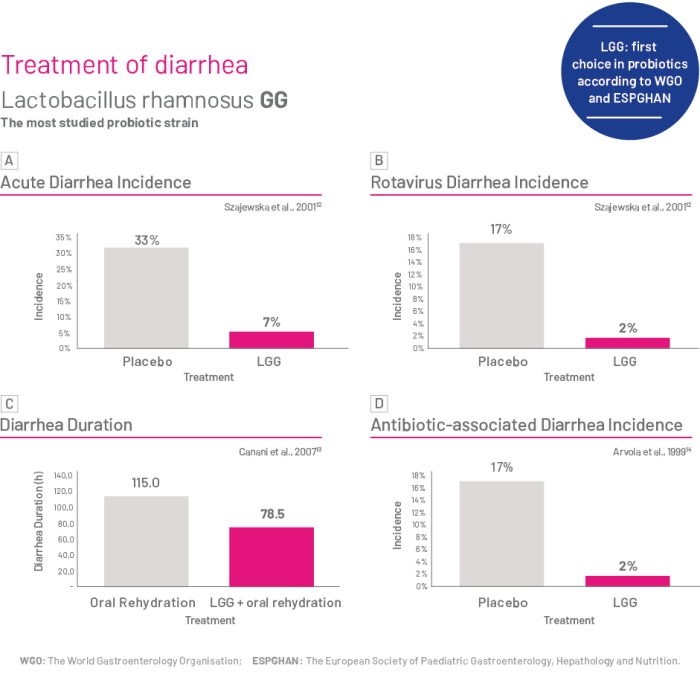
Fig1: Lactobacillus Rhamnosus GG reduces the incidence of diarrhoea. A: the number of acute diarrhoeal cases was reduced by 400% in the Lactobacillus Rhamnosus GG group vs. the placebo group. B: the incidence of diarrhoea caused by the rotavirus was 9 times lower in patients treated with Lactobacillus Rhamnosus GG compared with the placebo group. C: the duration of the diarrhoea was reduced by 32% when Lactobacillus Rhamnosus GG was used as a supplement during rehydration. D: the incidence of AAD (antibiotic associated diarrhoea) was 9 times lower in the Lactobacillus Rhamnosus GG group compared with the placebo group.
Graph source:
6 Tintore M et al. (2017) Gut Microbiota Dysbiosis and Role of Probiotics in Infant Colic. Arch Clin Microbiol. Vol. 8 No. 4:56 doi:10.4172/1989-8436.100056
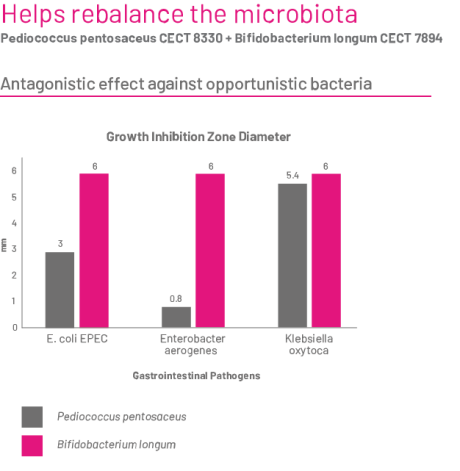
Fig2: Antagonistic effect of P. pentosaceus CECT 8330 and B. longum CECT 7894 against pathogenic bacteria. The effect of B. longum CECT 7894 is probably greater, although the methodology was unable to further detect this.
Graph source:
7 Szajewska H et al. Efficacy of Lactobacillus GG in prevention of nosocomial diarrhea in infants. J Pediatr 2001; 138: 361-5.
8 Canani RB et al. Probiotics for treatment of acute diarrhoea in children:randomised clinical trial of five different preparations. BMJ 2007; 335: 340-5.
9 Arvola T, Laiho K, Torkkeli S, Mykkänen H, Salminen S, Maunula L, Isolauri E. Prophylactic Lactobacillus GG reduces antibiotic-associated diarrhea in children with respiratory infections: a randomized study. Pediatrics. 1999 Nov;104(5):e64.
2. Why gut flora are crucial
The intestinal epithelium and the intestinal mucosal barrier are physical barriers, which regulate the exchange of water and nutrients between the environment outside the gut cavity and the body. This barrier function may be disrupted by an inflammatory process. This could give rise to a passive loss of water and dissolved substances from the body in the gut cavity, which can cause diarrhoea.
Viral infections can also undermine the epithelian/mucosal barriers. Various viruses, and the rotavirus especially, can infect the intestinal cells, causing loss of villi, impairing the exchange and absorption of water, electrolytes and nutrients. This situation can cause vomiting and diarrhoea, with significant loss of body fluids, which can give rise to dehydration. Various clinical studies have demonstrated th efficacy of specific Lactobacillus rhamnosus GG for the prevention and treatment of diarrhoea caused by rotavirus in infants and children.10 It exerts protective effects because of its ability to reduce the viral replication and adhesion to the epithelian cells in the intestinal mucus. Certain studies also showed that the protective action of Lactobacillus rhamnosus GG against viral infections is enhanced when it is administered as a preventative measure, i.e., before the infection occurs. 11
Sources:
10 Li YT, Xu H, Ye JZ, Wu WR, Shi D, Fang DQ, Liu Y, Li LJ. Efficacy of Lactobacillus rhamnosus GG in treatment of acute pediatric diarrhea: A systematic review with meta-analysis. World J Gastroenterol. 2019 Sep 7; 25(33): 4999–5016.
11 Luoto R, Ruuskanen O, Waris M, Kalliomaki M, Salminen S, Isolauri E: Prebiotic and probiotic supplementation prevents rhinovirus infections in preterm infants: A randomized, placebo-controlled trial. J Allergy Clin Immunol 2013.
Digest plus strains
The P. pentosaceus and B. longum strains, and especially P. pentosaceus CECT 8330, were shown to have potent anti-inflammatory properties, because they stimulate and induce the production of anti-inflammatory interleukins such as IL-103.
Sources:
3 Santas J et al. Pediococcus pentosaceus CECT 8330 and Bifidobacterium longum CECT 7894 show a trend towards lowering infantile excessive crying syndrome in a pilot clinical trial. Int J Pharma Bio Sci 2015; 6(2):P458–66.
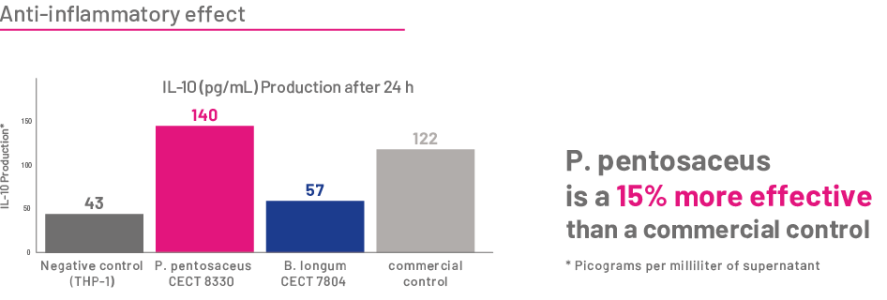
Fig. P. pentosaceus CECT8330 induces higher production of IL-10 (pg/mL) compared with B. longum CECT7894.
These bacterial strains therefore promote balance in inflammatory processes. Lactobacillus Rhamnosus GG also has the capacity to reinforce the barrier function of the intestinal epithelium by producing proteins that promote cell development. Lactobacillus rhamnosus GG has also been found to boost the immune system.2
Sources:
2 Segers ME, Lebeer S. Towards a better understanding of Lactobacillus rhamnosus GG - host interactions. Microbial Cell Factories. 2014;13(Suppl 1):S7-S23.



